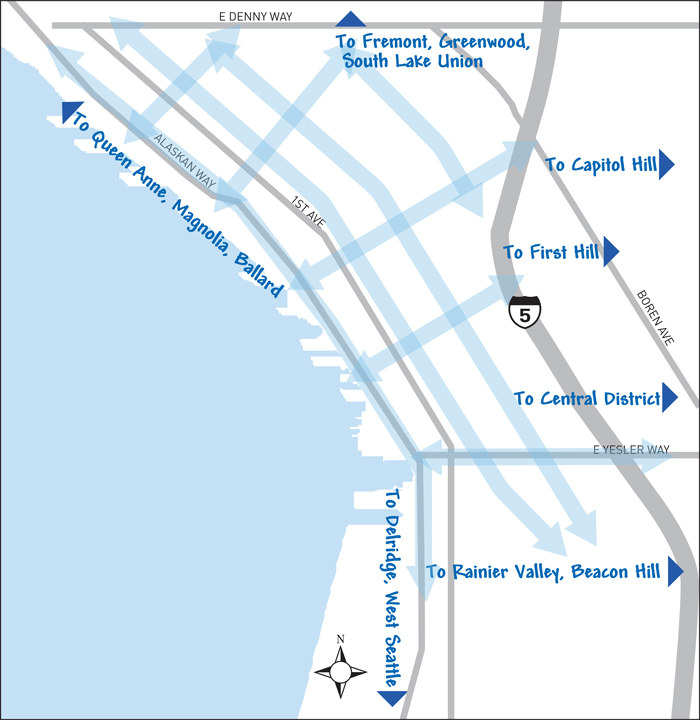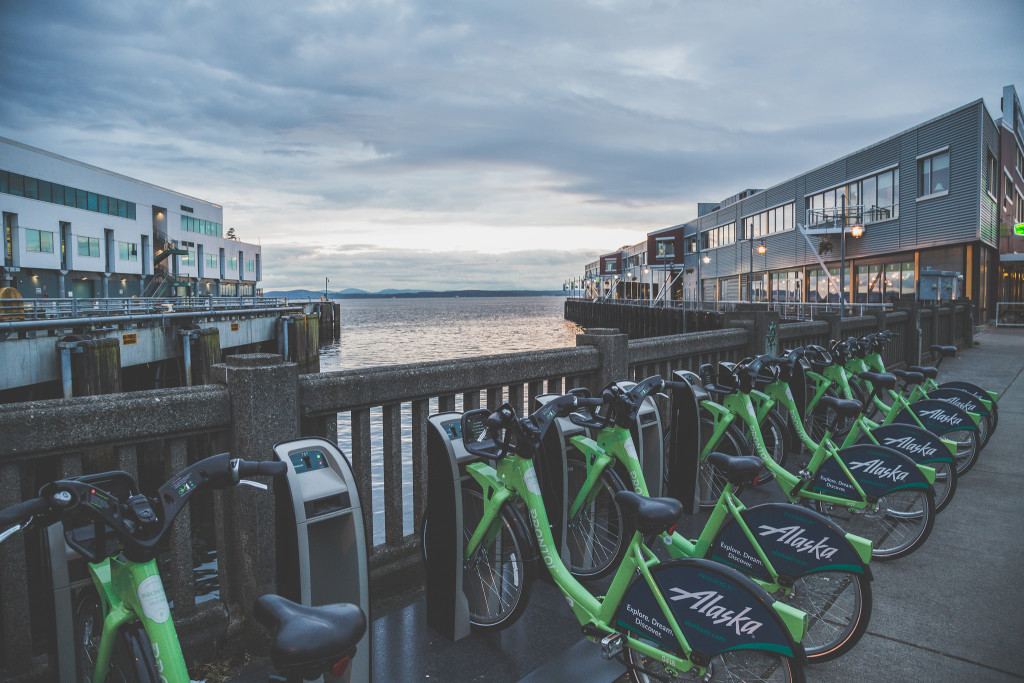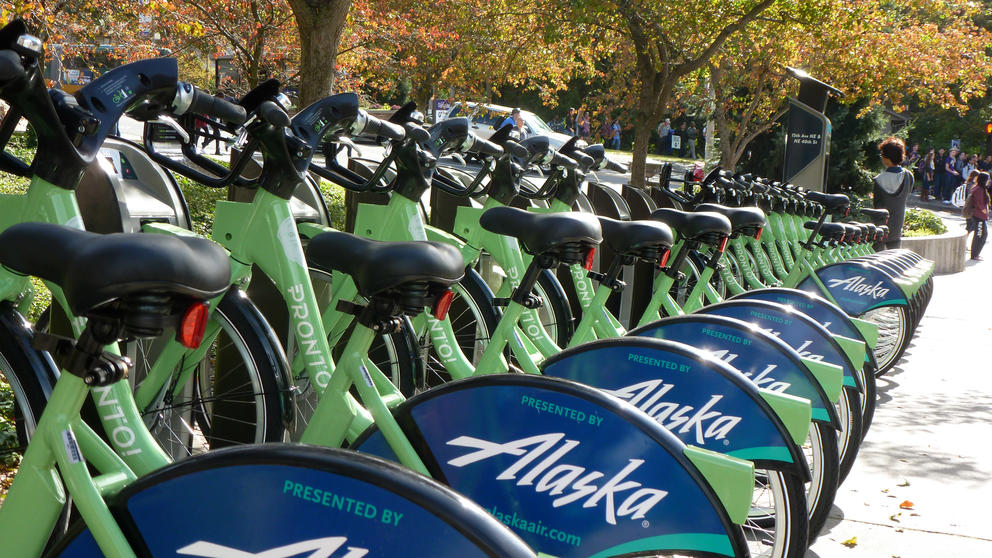Elizabeth Kiker doesn’t want to armchair quarterback the 2014 rollout of Pronto, Seattle's citywide network of "bike share" stations. “It didn’t happen exactly the way they wanted it to,” is all the executive director of the Cascade Bicycle Club says. She settles with this assessment: “It’s really complicated.”
Although Kiker may not want to backseat-drive, plenty of others are certainly willing to weigh in critically on Pronto's false start. For Seattle Times’ writer Brier Dudley, it’s a “neat amenity” that simply doesn’t work. Danny Westneat, Times' news columnist, sees it as a symbolic disconnect between how the city sees itself — bike-friendly — and what the city is — bike-a-phobic.
Others foresee a good future for bike sharing in Seattle if the city is smart about it. Tom Fucoloro, writing in rich detail on his Seattle Bike Blog, argues “bike share can flourish in Seattle,” but only with fixes. His proposals include ditching Pronto's underused University of Washington stations, abandoning King County’s helmet law – because providing helmets adds substantial costs to overall operation – and, most significantly, building the Center City Bike Network, a proposed interconnected system of protected bike lanes downtown.
Kiker echoes the importance of that last point. When eventually built, the Center City Bike Network will be a grid of protected bike lanes throughout downtown. Second Avenue is the template. But so far, progress has not been nearly as fast as bike advocates had hoped. As anyone who's taken a ride north on Second knows, the trail ends around Pike Place Market and bicyclists are left wondering where to go next. If Kiker had her way, “I would buy 400 gallons of paint and 5,000 planters” to build out the network.

After only a year of operation, the network of green cruiser bikes known as Pronto is in a do-or-die situation. In fact, if the city doesn't step in by March 1, Pronto won't be able to pay its bill to parent company Motivate and will shutter operations.
So the Seattle City Council is faced with a choice: Gamble that Seattle has a future in bike sharing and buy the program for the $1.4 million dollars it needs, or call quits on the whole thing, something that already has brought questions from the environmentally-minded chair of the council's transportation committee, Councilmember Mike O'Brien.
The Mayor's Office says it is working on an analysis of Pronto, and hasn't come out one way or the other. SDOT, meanwhile, has apparently sunk about $300,000 into keeping Pronto afloat, according to Josh Feit at Publicola.
Some have argued Pronto would be doing fine, were it not for a lapse on the part of the city. The city came forward with a proposal to take over the bike share operation last May. But nine months later, that proposed takeover still hasn’t happened. Meanwhile, Puget Sound Bike Share, the nonprofit coordinating the program, had all but dissolved by late last year and attempts at private fundraising had ceased. In the grand scheme, $1.4 million isn't that much for the city. But it's a lot of money in the face of uncertainty.
Knowing what went wrong is a tricky thing. Bike share in the United States is relatively new, so precedent is limited. And even if there was a long history of successful models, answering questions of feasibility takes something of a CAT-scan of a given city’s psyche.
“The number one thing is that each city is so different,” says Sue Baldwin of the Denver B-Cycle bike share. For every finance model, there’s an equal amount of speculation about the broad behavior of people in Washington D.C., or Cincinnati, or Seattle. Does bike share do better or worse in cities with a large number of bike commuters? How much does weather effect people’s willingness to bike? Does the hill climb to Capitol Hill doom round trips in Seattle? And does the behavior of one city's population tell us anything about the behavior of another's?
Bikeshare is almost always a partnership between a local organization and a larger corporation that provides the infrastructure for bike share, a kind of franchise business.. When Holly Houser was hired to run Puget Sound Bike Share, the nonprofit's board of directors gave her three tasks: Raise enough money so she could be paid, raise enough money to launch the program, and put out a request for proposals from established bikeshare providers.
PSBS received five proposals, two of which were taken seriously: Alta and B-Cycle. This was an important moment for Seattle’s bike share as it represented a commitment not only to a company, but also to a model of how Pronto would be run. Alta – which would later be purchased and renamed Motivate – functions very much like a full-service franchise. It provides bikes, stations and software in addition to operations like maintenance, bike distribution and marketing. Each local organization maintains sponsorship recruitment and pays a monthly per station fee to Motivate for everything else. This is the model now in cities like New York, Toronto, Portland and others.
B-Cycle, at least when PSBS was considering proposals, only provided the equipment, not ongoing operations. This is the model in Denver and Cincinnati, among other places.
Both models have their advantages and disadvantages. The costs of the B-Cycle model look more like line item payment, just as you’d pay off a car. This puts more control in the hands of the local operator.
The CEO of Cincinnati’s Red Bike, Jason Barron, talks about running bikeshare as running his own small business, finding as many efficiencies as he can. “We’ve been really lean at every cost,” he says.
The problem, however, is that the B-Cycle model requires a lot more resources up front. This worked in Cincinnati because, unlike Seattle, the city provided matching funds. Combined with significant support from the Haile Foundation, the enthusiasm of two neighboring cities, and the smaller size of Cincinnati, Red Bike’s initial standing was strong.
In Denver, there was similar support from the city. It also helped that the pilot program was introduced during the 2008 Democratic National Convention, when Barack Obama filled a stadium and lots of visitors wanted to try the new bike option.

Seattle, on the other hand, didn’t have support from the city and had issues conscripting the support of other nonprofits. As a result, upfront resources to handle the operations that would have been a local responsibility B-Cycle simply weren’t there. (Plus, B-Cycle uses solar technology to power its bike stations and the company had legitimate concerns that Seattle was not sunny enough.) Alta, therefore, won the contract.
Nicole Freedman, Seattle Department of Transportation’s chief of active transportation, publicly questioned the structure of that relationship in a Feb. 2 Seattle City Council Sustainability and Transportation Committee meeting. “The nonprofit owns the system, but hires a third party for operations,” she said, therefore “not getting the benefit of lower cost operations.” Her assumption here is that if Pronto were run in the style of Cincinnati, with the ability to manage, as Barron said, a “lean” operation, costs would necessarily be lower.
Ref Lindmark, Pronto’s board president, said in an e-mail that Motivate does have a series of incentives, around items like quick maintenance and speedy bike redistribution, to make sure the system is functioning “at the highest level.”
“Overall, I think Motivate has performed well for us," Lindmark said. "We have had some unplanned successes, some things we could do better on and some things that we just couldn’t plan for.”
Freedman’s second criticism was that ridership projections were overly optimistic. Much has been made of Pronto’s underwhelming use, but in fact, for the city’s 54 stations, Pronto's 144,000 rides are about where one might expect. Denver had similar numbers. In Cincinnati, Barron says he would be happy to have that ridership.
But according to Freedman, the predictions that ridership would go even higher led to a larger loan being taken by Pronto that is eating into sponsorship revenues, while monthly dues went nowhere.
In Cincinnati, the opposite happened. "[B-Cycle] projected 52,000 rides in the first year," said Barron. "We ended up doing 102,000 rides." In combination with higher than expected membership, the company's coffers were relatively full.
Freedman’s critique has been met with pushback from those who say it was a miscommunication with the city itself, not an outsized loan, that led Pronto to where it is now. “The main issue for Pronto now is the delay in the city implementing its planned acquisition of Pronto,” said Lindmark. “We were ready for it to happen last spring/summer … and here we are today.”
“They’re making it sound like we took out this huge loan," Houser told Seattle Bike Blog. In fact, Houser argues, it was not an abnormal loan.
A failed federal grant application certainly didn't help, which would have helped Pronto pay off its debts.
If there is one thread between the relative success or, at least, sustainability of bike share in Denver, Cincinnati and Washington D.C., it’s that each program started slowly and grew outward. “They started with a tight radius and moved out from there,” says Cascade Bicycle Club's Kiker of the D.C. system. Now, she says, stations are so plentiful it’s easier to bike than to walk because you pretty much can go point-to-point in a lot of situations.
Denver and Cincinnati functioned similarly, starting in highly connected areas and growing with demand. The combination of holistic growth and an infrastructure that connects stations put the companies in as good of a position as they can be.
That isn’t to say the rollouts in these other cities was flawless. Far from it. “It wasn’t sunshine all the time,” says Kiker of the D.C. experience. Sue Baldwin of Denver tells of a huge number of back end problems and “hectic” customer service.
But the slow growth put the systems in a position to adjust to demand.
Will bikeshare work if it's bailed out? That’s the $1.4 million question.
Lindmark, Kiker, Fucoloro and Houser are emphatic that, if matched with movement toward the Center City Bike Network, yes. Having a logical and safe route that connected the stations would open up the network to downtown workers going to lunch or their next meeting. The bike network is not contingent on the success of bike share — it's planned regardless of Pronto. But it's possible that bikeshare could end up being contingent on the bike network.
Since Seattle first began looking into a bikeshare, the industry has grown tremendously. Software is better functioning and other companies have entered the marketplace creating more competition. B Cycle is now partnering with an operating company, LA System, that didn’t exist when Seattle was considering the program.
“It is also worth pointing out that most new contracts with bikeshare companies are significantly different today than when we wrote ours,” said Lindmark. “Competition does wonders for selecting.”
If the city chooses to take over Pronto, it could put out a new request for proposal and, in Lindmark's view, perhaps have a better menu of contract options than it had before. A restart, in other words, could be just what the system needs.
Originally posted February 19.



